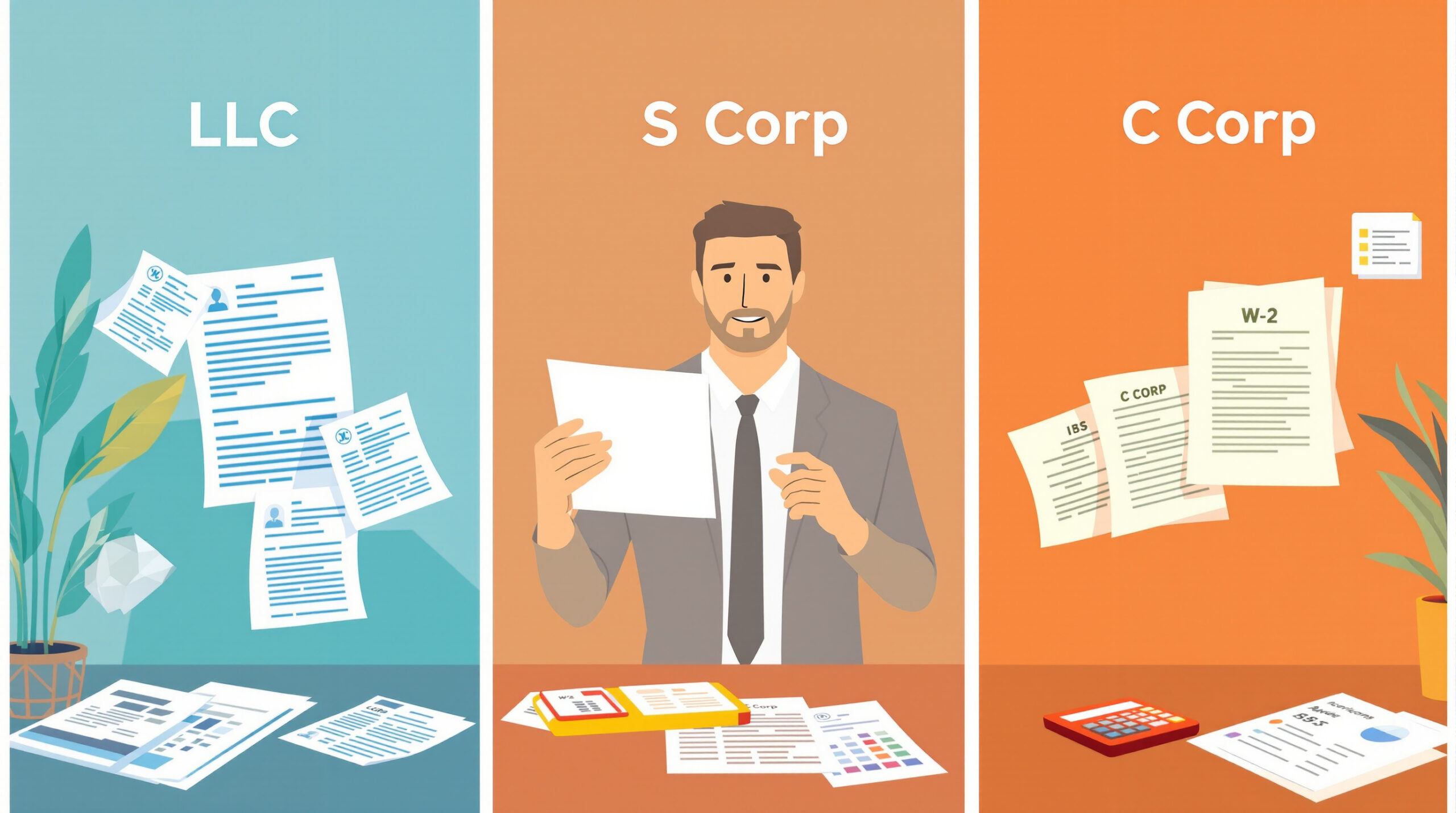LLC Versus S Corp and C Corp: The High-Stakes Decision That Can Make or Break Your California Tax Bill in 2025
Most owners and high-income earners in California lose $18,000–$42,000 annually because they never reconsider their entity structure—clinging to what worked in the past. For 2025, the gap between an LLC, S Corp, and C Corp is not just legal—it’s a cash difference on every quarter’s tax payment.
This year, rules and tax rates for pass-throughs and corporations shifted again. If you still rely on dated advice, you miss out. Below is a strategist’s guide to llc versus s corp and c corp—what truly matters for W-2 employees with side gigs, 1099s, business owners, and real estate investors across California in 2025.
Quick Bottom Line: Most business owners in California save $8,000–$30,000 on taxes annually by choosing the optimal structure—and take home more after FTB and IRS cut their slice. The wrong move could double your audit risk or expose you to brutal California fees. Let’s break it down in plain English.
This information is current as of 11/19/2025. Tax laws change frequently. Verify updates with the IRS or FTB if reading this later.
LLC Versus S Corp and C Corp: What’s the Actual Difference in 2025?
Featured Answer: An LLC in California offers maximum flexibility with pass-through taxation, but no payroll tax savings. S Corps deliver major self-employment tax reduction by splitting salary and distributions (average client savings $14,400/year). C Corps offer flat rates (21% at the federal level, plus CA), but expose profits to double taxation if you pay yourself beyond reasonable comp. The structure you choose affects not just taxes, but audit risk, deductions, California compliance fees, and equity planning for growth or sale.
How an LLC Operates in California for 2025
LLCs (Limited Liability Companies) are the default choice for flexibility, especially for new businesses, solopreneurs, or real estate investors. You pay federal tax on all business profits—whether you keep the money or not—via personal tax return (Schedule C for individuals, or 1065 for partnerships).
- California LLC Fee: Minimum $800 franchise tax, plus a gross receipts fee ($900–$11,790) if annual revenue crosses $250,000 (see FTB reference).
- Self-Employment Tax: You pay both the employer and employee side (15.3% up to Social Security wage base, 2.9% Medicare unlimited).
- Typical Write-Offs: Nearly anything ordinary and necessary: home office, vehicle, supplies, benefits—but you get NO savings on self-employment tax.
Example: Keisha, a San Diego web developer earning $175,000 via her LLC, pays about $22,000 in self-employment tax, plus $800 to $2,500 in California fees—before deducting her home office, which nets another $2,100/year.
S Corps: The Go-To for Payroll Tax Savings in 2025
S Corps (S Corporations) allow owners to split income into “salary” (reported on W-2) and “distributions” (not subject to self-employment tax). The IRS expects your salary to be “reasonable” (based on your industry and duties—see IRS S Corporation rules).
- Payroll Tax Game Changer: Only your salary is hit with Social Security/Medicare taxes (15.3%); distributions skip payroll tax entirely. If your profit is $200,000 and you pay yourself a $100,000 salary, you could save roughly $15,300 annually.
- Formalities: You must run payroll and file additional forms (1120S + K-1). California still charges $800 minimum franchise tax, plus 1.5% of net income.
- Eligibility: Maximum of 100 individual shareholders (no C Corps, partnerships, or foreign investors), must be US citizens/residents.
Example: David, a Los Angeles marketing consultant with $240,000 profit after expenses, switches his LLC to S Corp status. Assigning himself a reasonable $110,000 salary, he cuts $19,845 in self-employment tax (distribution portion of $130,000 skips payroll tax entirely), less $1,500 in added compliance costs—still netting $18,345 in savings.
C Corps in California: When Does the Flat Tax Rate Actually Save You?
C Corporations pay corporate income tax directly, then any dividends paid to owners are taxed again on their individual return (double taxation). For 2025, federal corporate rate is 21%, and California adds 8.84%—but the first $8,000 is exempt from CA tax.
- Double Taxation: If you pay yourself via dividend, taxed again at personal rates (up to 23.8% federal long-term capital gains, plus CA up to 13.3%).
- Benefits: Potential for health, fringe, and retirement plan deductions; broad ownership (incl. non-US), no restrictions on shareholders.
- Who Wins: Startups reinvesting all profits, companies planning to go public, businesses needing venture capital, or those with substantial write-offs exceeding pass-through limits.
Example: Priya, a San Jose SaaS entrepreneur earning $480,000, keeps all profits in the business. Using a C Corp, she pays $100,320 in federal corporate tax, $37,632 CA tax, but is eligible for a $25,000 R&D credit, bringing her net tax burden down. She only triggers double taxation if she takes dividends personally.
Pro Tip: For a complete breakdown of S Corp strategies—including how to avoid disqualification and maximize payroll split—see our comprehensive S Corp tax guide.
KDA Case Study: Serial Entrepreneur Saves $19,900 Swapping LLC for S Corp
In 2023, a KDA client—an Orange County business owner juggling digital consulting and Amazon sales—ran both income streams through an LLC set up years earlier, bringing in $272,000 gross revenue with about $185,000 net profit. After reviewing their books, KDA calculated the client paid $27,131 in self-employment and state taxes in 2022 alone.
The client wanted to reinvest aggressively, so we recommended an S Corp election for 2023 onwards. Setting a $98,000 salary (per local market stats for consultants/e-commerce managers), we reduced subject payroll tax to $15,162 and their S Corp distributions avoided $13,323 in additional employment taxes. Compliance/admin rose by $2,800, but year one net savings totaled $19,900.
Actual KDA fees: $3,600 for compliance + strategy. ROI: Over 5x return in year one—plus reduced audit exposure due to clean payroll/W-2 records. The client rolled the tax savings into marketing and hit a record $340,000 the following year.
Ready to see how we can help you? Explore more success stories on our case studies page to discover proven strategies that have saved our clients thousands in taxes.
Pass-Through Flow-Through: What It Means for LLC, S Corp, and C Corp Owners
One of the biggest myths: “An LLC always has pass-through taxation; a C Corp is double-taxed; and S Corp is always best.” Truth: Both LLC and S Corp can pass income to your personal return, but only S Corp lets you split income between salary and profit for tax savings. A standard LLC, unless you specifically elect S Corp status, is exposed to full self-employment tax. A C Corp, by default, pays its own corporate tax and is only double-taxed when you pay yourself with dividends—not with salary or retained earnings.
- Single-member LLCs default to sole proprietorship—profits taxed on your personal 1040 (via Schedule C).
- Multi-member LLCs default to partnerships—profits split on each member’s K-1.
- S Corps must file 2553 with the IRS to elect S status—this doesn’t happen automatically.
Pro Tip: Making S Corp election retroactively creates headaches—do it at the start of the year (or within 75 days of forming/January 1st of the next year).
Why Most Business Owners Miss This Deduction
Red Flag Alert: The biggest mistake: Staying as an LLC too long. By default, new businesses set up as LLCs for simplicity. By year three, most are paying thousands more because they never revisit entity classification—even as profits skyrocket.
- W-2 employees with a side LLC can be hit with self-employment tax on all side income—unless S Corp election is made.
- 1099 gig workers with high net can end up in highest SE tax brackets within 24 months.
- Real estate investors using LLCs for short-term rentals miss major passive loss offsets (and, in some cases, violate FTB aggregation rules by mishandling property vs. active business income).
This can be resolved with one IRS form—most taxpayers never file it. See Form 2553 instructions for S Corp election. Getting this wrong means the IRS will treat you as a default LLC and deny late-breaking payroll tax strategies.
Calculating the Savings: Real-World Scenarios for Every Taxpayer
W-2 with Side Hustle
Lisa earns $135,000 in her full-time job and $48,500 from digital marketing consulting through an LLC. In 2025, she owes $7,420 in self-employment tax on her side gig. By switching to S Corp, setting a $30,000 reasonable salary, her tax drops $2,790. A simple entity tweak; significant personal ROI.
Multi-Member LLC Partners
Davinder and Tom run a property management business as an LLC with $365,000 profit. Each pays $22,297 in federal/state/SE tax. If they convert to S Corp and allocate $75,000 each as salary, they legally avoid $5,435 each in unnecessary payroll tax, splitting $215,000 of distribution cleanly.
C Corp Owner Focused on Benefits
Lauren, who runs a healthcare startup, uses a C Corp to offer a formal group health plan, $57,000 annual SEP IRA contributions, and broad equity incentives—a package not possible with her prior S Corp. She pays herself a flat $120,000 salary to avoid FTB’s double-taxed dividend issue.
Pro Tip: Choosing the right structure is not a one-time set-and-forget. Schedule an annual review, especially in California, where FTB and IRS audit triggers shift each year. Check our services overview page for ongoing compliance support.
How to Choose the Right Entity for 2025: Step-by-Step Guide
- Calculate Your True Net Profit after all ordinary business expenses for projected 2025 operations.
- Factor California LLC Fees and C Corp franchise taxes into your calculation.
- Assess Future Plans: Will you sell, raise capital, or keep the business in the family?
- Decide on Payroll: Are you able/willing to run payroll for yourself and keep clean records?
- Run the Numbers: Don’t guess! Get a side-by-side projection of LLC, S Corp, and C Corp tax outcomes for your scenario. Seek a pro’s help if you cross $120,000 in net annual profit.
For entities established prior to 2021, check if you’re missing out on new state deductions, SALT cap workarounds, or California’s elective pass-through tax solution—a tactic best suited for S Corps and partnerships to offset new federal limits (see FTB PTE Elective Tax).
Can I Switch My Entity Later or Fix Past Mistakes?
Absolutely—but acting fast is critical.
- You can retroactively elect S Corp status if you’re within 75 days of formation or the new tax year.
- Moving from sole proprietor/LLC to S Corp mid-year risks proration and confusing the IRS. If you wait until after you’ve paid yourself, payroll catch-up is required, often with penalties.
- Switching to C Corp is best for those raising outside capital. Merging or converting in California can trigger fee and FTB review—so document everything with entity structuring help.
What if you miss a deadline? The IRS may allow late elections if it was for reasonable cause. See IRS late S election guidance.
FAQ: Solving the Most Confusing LLC, S Corp, and C Corp Issues in 2025
What’s the actual tax difference between an LLC, S Corp, and C Corp?
LLCs and S Corps are both pass-through by default, meaning profits flow to your return. Only S Corps help you reduce payroll/self-employment tax. C Corps pay tax at corporate rates; profits taxed again if paid out as dividends.
Do I need to form a new company to switch from LLC to S Corp (or vice versa)?
No. You can “elect” to be taxed as S Corp via IRS Form 2553. Your company’s legal structure doesn’t change—just its tax reporting setup. But be wary of California-specific rules and deadlines.
Can my LLC be taxed as S Corp or C Corp?
Yes, with IRS election via Form 2553 (for S Corp) or Form 8832 (for C Corp). Many profitable single-owner LLCs become S Corps for payroll tax reasons. Be sure to follow up on FTB compliance in California.
How much should I pay myself as a “reasonable” S Corp salary?
IRS expects your salary to match what you’d pay someone else for the same work—think $70,000–$125,000 for high-skill solo owners, but local market and role matter. Too low will attract FTB/IRS scrutiny. See IRS guidance on reasonable compensation (Publication 15).
Will switching entities increase my audit risk?
Only if you skip formalities. S Corps demand proper payroll, timely 2553 filing, and K-1 forms for owners. Missing these is a major red flag for both IRS and FTB audits in California. But clean records = lower exposure.
Book Your Advanced Entity Review Now
Still running your business as an LLC or sole proprietorship? You’re leaving serious cash (and audit headaches) on the table. Book a confidential tax entity review with our strategist team—so you keep what’s yours and avoid outsized penalties in 2025. Click here to claim your session now.




